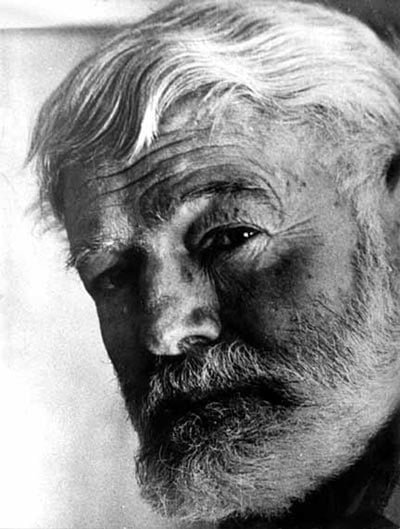
Ernest Hemingway was born inn Oak Park, Illinois. His mother Grace Hall, whom he never forgave for dressing him as a little girl in his youth, had an operatic career before marrying Dr. Clarence Edmonds Hemingway; he taught his son to love out-door life. Hemingway’s father took his own life in 1928 after losing his health to diabetes and his money in the Florida real-estate bubble. Hemingway attended the public schools in Oak Park and published his earliest stories and poems in his high school newspaper. Upon his graduation in 1917, Hemingway worked six months as a reporter for The Kansas City Star. He then joined a volunteer ambulance unit in Italy during World War I. In 1918 he suffered a severe leg wound. For his service, Hemingway was twice decorated by the Italian government.
Hemingway’s affair with an American nurse, Agnes von Kurowsky, during his hospital recuperation gave basis for the novel A Farewell To Arms (1929). The tragic love story was filmed first time in 1932.
After the war Hemingway worked for a short time as a journalist in Chicago. He moved in 1921 to Paris, where wrote articles for the Toronto Star. In Europe, the centre of modernist movement, Hemingway associated with such writers as Gertrude Stein and F. Scott Fitzgerald, who edited some of his texts and acted as his agent.
Hemingway’s first books, Three Stories And Ten Poems (1923), of which he received no advance at all, and In Our Time (1924), were published in Paris. The Torrents Of Spring appeared in 1926 and Hemingway’s first serious novel, The Sun Also Rises, on the same year. Hemingway wrote and rewrote the novel in various parts of Spain and France between 1924 and 1926. It became his first great success. Although the Hemingway’s language is simple, he used understatement and omission which make the text multilayered and rich in allusions.
After the publication of Men Without Women (1927), Hemingway returned to the United States, settling in Key West, Florida. Hemingway and Hadley divorced in 1927. On the same year Hemingway married Pauline Pfeiffer, a wealthy fashion editor. In Florida he wrote A Farewell to Arms, which was published in 1929. Its scene is the Italian front in World War I, where two lovers find a brief happiness. The novel gained enormous critical and commercial success.
In 1930s Hemingway wrote such major works as Death In The Afternoon (1932), a nonfiction account of Spanish bullfighting, and The Green Hill Of Africa (1935), a story of a hunting safari in East Africa. To Have And Have Not (1937) was made into a film by the director Howard Hawks. They had became friends in the late 1930s.
One of Hemingway’s most frequently anthologized short stories is ‘The Snows of Kilimanjaro,’ first published in Esquire in August 1936.
In 1937 Hemingway observed the Spanish Civil war firsthand. As many writers, he supported the cause of the Loyalist. In Madrid he met Martha Gellhorn, a writer and war correspondent, who became his third wife in 1940. The first years of his marriage were happy, but he soon realized that Gellhorn was not a housewife, but an ambitious journalist. Gellhorn called Hemingway her “Unwilling Companion”. She was eager to travel and “take the pulse of the nation” or the world.
With To Whom The Bells Toll (1940) Hemingway returned again in Spain.
In addition to hunting expeditions in Africa and Wyoming, Hemingway developed a passion for deep-sea fishing in the waters off Key West, the Bahamas, and Cuba. He also armed his fishing boat, and monitored with his crew Nazi activities and their submarines in that area during World War II. In 1940 Hemingway bought a house outside Havana, Cuba. Its surroundings were a paradise for his undisciplined bunch of cats.
In early 1941 Gellhorn made with Hemingway a long, 30,000 mile journey to China. Just before the Invasion of Normandy in 1944, Hemingway managed to get to London, where he settled at the Dorchester Hotel. In 1946 Hemingway returned to Cuba. After Gellhorn had left him, he married Mary Welsh, a correspondent for Time magazine, whom he had met in a London restaurant in 1944.
Across the River and Into the Trees, Hemingway’s first novel in a decade, was poorly received, but the allegorical 27,000 word story The Old Man And The Sea, published first in Life magazine in 1952, restored again his fame.
Much of his time Hemingway spent in Cuba until Fidel Castro’s 1959 revolution. He supported Castro but when the living became too difficult, he moved to the United States. While visiting Africa in 1954, Hemingway was in two flying accidents and was taken to a hospital. In the same year he started to write True At First Light, which was his last full-length book. Part of it appeared in Sports Illustrated in 1972 under the title African Journal.
In 1960 Hemingway was hospitalized at the Mayo Clinic in Rochester, Minnesota, for treatment of depression, and released in 1961. During this time he was given electric shock therapy for two months. On July 2 Hemingway committed suicide with his favourite shotgun at his home in Ketchum, Idaho. Several of Hemingway’s novels have been published posthumously. True at First Light, depiction of a safari in Kenya, appeared in July 1999.
